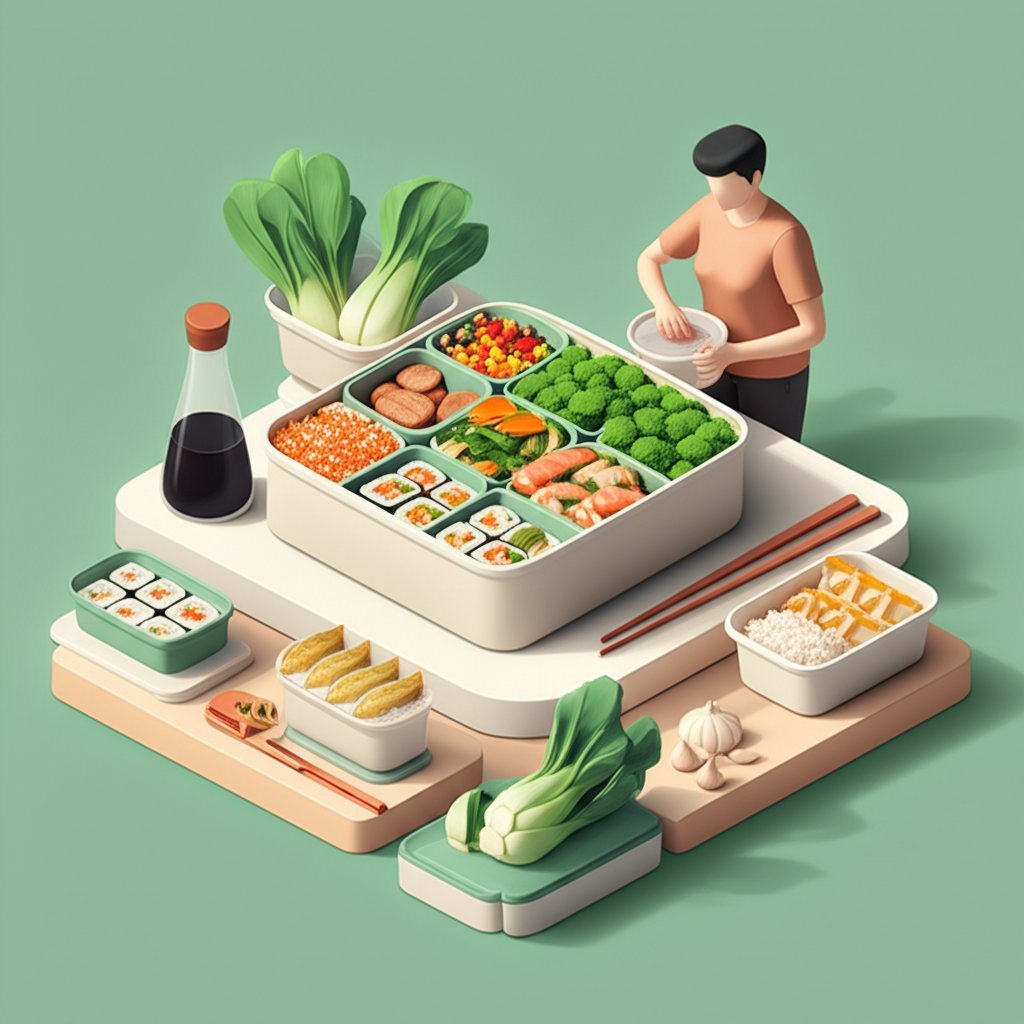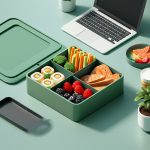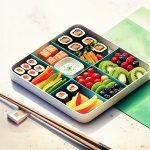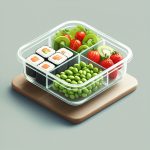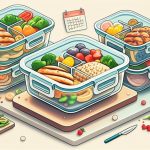It’s Tuesday night, and the craving for a spicy, savory Korean beef bowl hits hard. But the thought of chopping, marinating, and cooking after a long day feels impossible, so you reach for takeout again. The secret to breaking this cycle is effective meal prep asian food, a strategy that transforms your week from stressful scrambling to delicious, effortless dining. It’s not about eating the same bland chicken and broccoli five days in a row; it’s about unlocking a world of vibrant, complex flavors with just a little bit of planning.
This guide breaks down the simple, repeatable systems that make Asian meal prep work. We’ll move beyond just listing recipes and dive into the frameworks and techniques that keep your food fresh, flavorful, and exciting all week long.
At a Glance: Your Path to Flavorful Prep
Here’s what you’ll learn to master your weekly Asian meal prep:
- Two Core Methods: Discover the difference between “Component Prep” for flexibility and “Batch Cooking” for convenience.
- Pantry Power: Learn the essential, flavor-building ingredients that form the backbone of countless Asian dishes.
- A 90-Minute Game Plan: Follow a step-by-step workflow to get your entire week’s prep done efficiently.
- Smart Storage Secrets: Understand the “Ramen Rule” and other techniques to avoid soggy noodles and sad salads.
- Reheating for Success: Find out the best ways to bring your prepped meals back to life without sacrificing texture.
- Common Pitfalls to Avoid: Learn which dishes are best for the fridge versus the freezer.
The Foundation: Two Smart Approaches to Asian Meal Prep
Successful meal prep isn’t a one-size-fits-all solution. Your best strategy depends on your schedule and how much variety you crave. Most successful approaches fall into one of two categories.
Method 1: The “Component Prep” Artist
This method is all about flexibility. Instead of cooking complete meals, you prepare individual ingredients that can be mixed and matched throughout the week. It’s perfect for building different bowls, salads, and stir-fries on the fly.
- What it looks like: On Sunday, you’ll grill teriyaki chicken thighs, cook a large batch of jasmine rice, chop bell peppers and bok choy, and mix a peanut-lime dressing.
- How you use it:
- Monday: Teriyaki chicken bowl with rice and steamed bok choy.
- Tuesday: Asian chicken salad using the leftover chicken, chopped veggies, and peanut dressing.
- Wednesday: A quick chicken and veggie stir-fry.
A great example is prepping for a Korean Beef Bowl. You can cook the marinated ground beef, steam some broccoli, and pickle some radishes all separately. Each night, you just assemble a bowl—it takes less than five minutes but tastes incredibly fresh.
Method 2: The “Batch Cooking” Powerhouse
This is the ultimate grab-and-go method. You cook large batches of complete dishes that store and reheat well. It’s the definition of convenience for those extra-busy weeks where you just want to heat and eat.
- What it looks like: You make a big pot of Coconut Milk Curry with Chicken or a slow-cooker full of Filipino Chicken Adobo.
- How you use it: Portion the finished dishes into individual containers. When you’re ready to eat, simply pop one in the microwave or reheat it on the stovetop.
This approach works beautifully for saucy, stew-like dishes. Curries, rendang, and braises often taste even better the next day as the flavors have more time to meld.
| Prep Method | Pros | Cons | Best For |
| :— | :— | :— | :— |
| Component Prep | High flexibility, fresher taste, prevents texture issues. | Requires nightly assembly (2-5 mins). | Bowls, salads, stir-fries. |
| Batch Cooking | Maximum convenience, zero nightly effort, flavors deepen over time. | Less variety, not all textures hold up well. | Curries, stews, soups, braises. |
Building Your Asian Meal Prep Pantry
You can’t create amazing flavors without the right tools. Having a well-stocked pantry is the first step. You don’t need a hundred different bottles; a few versatile workhorses can create dozens of distinct flavor profiles.
- Umami & Salt: Soy sauce (or tamari for gluten-free), fish sauce, miso paste. These provide the savory, salty depth that is the foundation of many dishes.
- Aromatics: Ginger, garlic, scallions. Buy them fresh. You can pre-mince garlic and store it in a jar with olive oil, or make a ginger-garlic paste in a food processor to save time.
- Acid & Sweet: Rice vinegar, lime juice, mirin (sweet cooking wine). These brighten and balance the rich, savory flavors.
- Heat & Funk: Sriracha, gochujang (Korean chili paste), chili-garlic sauce. A little goes a long way in adding complexity and spice.
- Fats & Oils: Toasted sesame oil (use as a finishing oil, not for high-heat cooking), coconut milk (full-fat for richness).
With just these items, you can whip up marinades for a Honey Hoisin Beef Bowl, a dressing for a Sichuan Bang Bang Chicken salad, or the base for a Thai Coconut Soup.
Your Weekly Game Plan: From Shopping to Storing
Here’s a simple, repeatable workflow to take you from planning to a fridge full of delicious options.
Step 1: Choose Your Recipes (The 3-Day/7-Day Split)
The key to keeping food fresh is knowing what to eat when. Plan your week around two categories: fresh-friendly meals for days 1-3 and freezer-friendly meals for days 4-7.
- For Days 1-3: Pick recipes with components that hold up well in the fridge. Think Crockpot Chicken Teriyaki, Hibachi Chicken with vegetables, or the components for a Keto Ahi Poke Bowl (keeping the fish and avocado separate until serving).
- For Days 4-7: Choose dishes that freeze and reheat beautifully. This is where batch-cooked meals like Indonesian Jackfruit Rendang, Healthy Orange Chicken, or Keto Asian Turkey Meatballs shine.
For a comprehensive list of ideas that fit both categories, our guide to Flavorful Asian meal prep ideas offers over 40 recipes, all designed to be healthy and budget-friendly.
Step 2: The Sunday Prep Session (Your 90-Minute Plan)
Set aside about 90 minutes to execute your plan. Work in batches to be as efficient as possible.
- Start the Grains (1 min): Get your rice, quinoa, or other grains cooking in a rice cooker or on the stove. This is hands-off time.
- Wash & Chop Veggies (20 mins): Wash and chop all the vegetables for your week’s recipes. Store them in airtight containers. For greens like bok choy, you can place a paper towel in the container to absorb excess moisture.
- Mix Sauces & Marinades (15 mins): Whisk together all your dressings, marinades, and sauces in mason jars. This is the single biggest flavor-boosting step you can take.
- Cook Proteins (40 mins): While the veggies and sauces are done, cook your proteins. This could be grilling chicken thighs, browning ground beef for Bulgogi bowls, or baking miso-glazed salmon.
- Cool & Store (15 mins): Let everything cool completely before storing. Storing hot food creates condensation, which leads to sogginess and faster spoilage.
Step 3: The Art of Smart Storage
How you store your food is just as important as how you cook it. The goal is to protect texture and prevent everything from becoming a soggy mess.
- The Ramen Rule: Never store noodles in broth. For dishes like Asian Chicken Noodle Soup, keep the broth separate and combine with the noodles and other toppings just before reheating. This preserves the perfect texture of the noodles.
- The Bowl Blueprint: Use divided containers or store components separately. For a Japanese Buddha Bowl, you’d keep the tofu, roasted sweet potatoes, seaweed salad, and dressing in their own compartments until it’s time to eat.
- The “Dress Later” Doctrine: For salads like the Asian Chicken Salad, always store the dressing separately. Add it just before serving to keep the lettuce crisp and the almonds crunchy.
- The Curry & Stew Strategy: These are the easiest. Once cooled, they can be stored in single-serving containers, ready to go. They are ideal candidates for the freezer.
Quick Answers to Common Meal Prep Puzzles
Even with a solid plan, questions pop up. Here are a few common ones.
Q: How do I prevent my prepped noodles from getting soggy?
A: After cooking noodles like udon or lo mein, rinse them under cold water to stop the cooking process. Toss them with a tiny amount of sesame oil to prevent sticking before storing them in an airtight container.
Q: What’s the best way to reheat Asian meal prep?
A: It depends on the dish. Stir-fries and fried rice are best reheated in a hot wok or skillet for 2-3 minutes to revive their texture. Curries, soups, and braises reheat perfectly in the microwave. For bowls, microwave the protein and grains, then add fresh toppings like pickled vegetables or fresh herbs after.
Q: Can I really meal prep seafood?
A: Yes, but with a shorter timeline. Cooked shrimp and firm fish like salmon are great for 1-2 days. A Baked Salmon Teriyaki is perfect for Monday or Tuesday’s lunch. Avoid delicate fish, and never prep raw fish (like for poke bowls) more than a few hours ahead.
Q: What Asian dishes freeze the best?
A: Soups, curries, and braised meats are top-tier freezer meals. Filipino Chicken Adobo, Malaysian Fish Curry, and Tofu Tikka Masala all freeze exceptionally well. Portion them into freezer-safe containers for easy thawing. Avoid freezing anything with a creamy, dairy-based sauce (unless it’s coconut milk, which freezes well) or vegetables with high water content, like cucumber.
Your First Step to Effortless Weeknight Flavor
Getting started with meal prep asian food doesn’t require a radical overhaul of your life. Start small. Pick one “component prep” bowl and one “batch cook” curry for the week. Make a smart shopping list, block out 90 minutes on a Sunday, and follow the workflow.
You’ll be amazed at how a little bit of upfront effort completely transforms your weeknights. That delicious, home-cooked Asian meal is no longer a fantasy—it’s waiting for you in the fridge, ready in minutes.
- Adult Bento Box Lunch Ideas For Quick Healthy Portable Options - December 25, 2025
- Adult Bento Meal Ideas for Delicious, Easy, and Healthy Lunches - December 24, 2025
- Adult Bento Box Ideas for Delicious and Easy Lunches - December 23, 2025
